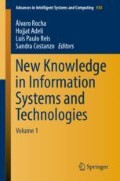Abstract
Traffic flow forecasting has been in the mind of researchers for the last decades, remaining a challenge mainly due to its stochastic nonlinear nature. In fact, producing accurate traffic flow predictions would be extremely useful not only for drivers but also for those more vulnerable in the road, such as pedestrians or cyclists. With a citizen-first approach in mind, forecasting models can be used to help advise citizens based on the perception of outdoor risks, dangerous behaviors and time delays, among others. Hence, this work develops and evaluates the accuracy of different ARIMA and LSTM based-models for traffic flow forecasting on data-scarce and non-data-scarce environments. The obtained results show the great potential of LSTM networks while, in contrast, expose the poor performance of ARIMA models on large datasets. Nonetheless, both were able to identify trends and the cyclic nature of traffic.
Access this chapter
Tax calculation will be finalised at checkout
Purchases are for personal use only
References
Cortez, P., Rocha, M., Neves, J.: Evolving time series forecasting ARMA models. J. Heuristics 10(4), 415–429 (2004)
Babu, C., Reddy, B.: Predictive data mining on Average Global Temperature using variants of ARIMA models. In: IEEE International Conference on Advances in Engineering, Science And Management (ICAESM 2012), pp. 256–260 (2012)
Li, K., Zhai, C., Xu, J.: Short-term traffic flow prediction using a methodology based on ARIMA and RBF-ANN. In: 2017 Chinese Automation Congress (CAC), pp. 2804–2807 (2017)
Graves, A., Mohamed, A., Hinton, G.: Speech recognition with deep recurrent neural networks. In: IEEE International Conference on Acoustics, Speech and Signal Processing, pp. 6645–6649 (2013)
Fu, R., Zhang, Z., Li., L.: Using LSTM and GRU neural network methods for traffic flow prediction. In: 31st Youth Academic Annual Conference of Chinese Association of Automation (YAC), pp. 324–328 (2016)
Zhao, Z., Chen, W., Wu, X., Chen, P., Liu, J.: LSTM network: a deep learning approach for short-term traffic forecast. IET Intel. Transp. Syst. 11(2), 68–75 (2017)
Ma, X., Tao, Z., Wang, Y., Yu, H., Wang, Y.: Long short-term memory neural network for traffic speed prediction using remote microwave sensor data. Transp. Res. Part C: Emerg. Technol. 54, 187–197 (2015)
Guan, W., Hua, X.: A combination forecasting model of urban ring road traffic flow. In: Proceedings of the IEEE Intelligent Transportation Systems Conference, pp. 671–676 (2006)
Scikit-learn: sklearn.preprocessing.MinMaxScaler (2018). http://scikit-learn.org/stable/modules/generated/sklearn.preprocessing.MinMaxScaler.html. Accessed 10 Oct 2018
Box, G., Jenkins, G.: Time Series Analysis: Forecasting and Control (1976)
Van Der Voort, M., Dougherty, M., Watson, S.: Combining Kohonen maps with arima time series models to forecast traffic flow. Transp. Res. Part C: Emerg. Technol. 4(5), 307–318 (1996)
Graves, A., Schmidhuber, J.: Framewise phoneme classification with bidirectional LSTM and other neural network architectures. Neural Netw. Off. J. Int. Neural Netw. Soc. 18(5–6), 602–610 (2005)
Acknowledgments
This work has been supported by COMPETE: POCI-01-0145-FEDER-007043 and FCT – Fundação para a Ciência e Tecnologia within the Project Scope: UID/CEC/00319/2013, being partially supported by a Portuguese doctoral grant, SFRH/BD/130125/2017, issued by FCT in Portugal.
Author information
Authors and Affiliations
Corresponding author
Editor information
Editors and Affiliations
Rights and permissions
Copyright information
© 2019 Springer Nature Switzerland AG
About this paper
Cite this paper
Fernandes, B., Silva, F., Alaiz-Moretón, H., Novais, P., Analide, C., Neves, J. (2019). Traffic Flow Forecasting on Data-Scarce Environments Using ARIMA and LSTM Networks. In: Rocha, Á., Adeli, H., Reis, L., Costanzo, S. (eds) New Knowledge in Information Systems and Technologies. WorldCIST'19 2019. Advances in Intelligent Systems and Computing, vol 930. Springer, Cham. https://doi.org/10.1007/978-3-030-16181-1_26
Download citation
DOI: https://doi.org/10.1007/978-3-030-16181-1_26
Published:
Publisher Name: Springer, Cham
Print ISBN: 978-3-030-16180-4
Online ISBN: 978-3-030-16181-1
eBook Packages: Intelligent Technologies and RoboticsIntelligent Technologies and Robotics (R0)

